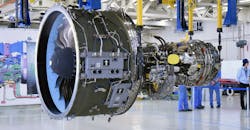Raytheon Increases Job Cuts to 15,000
Raytheon Technologies Corp., the holding company for Pratt & Whitney and Collins Aerospace, will add 6,500 jobs to the number it plans to eliminate as it works to address decreased demand in commercial aviation markets. The total number to be cut is now 15,000, as Raytheon manages the ongoing effect of the Covid-19 pandemic. A similar downsizing is underway among aircraft builders, jet engine manufacturers, and other suppliers in the sector.
Commercial air traffic is down 45% year-over-year, according to Raytheon CEO Greg Hayes in remarks to a virtual conference this week. Reduced activity results in reduced demand for new aircraft and component parts and structures, but also reduced maintenance requirements.
Raytheon will apply job cuts to reduce sales costs and general and administrative expenses at Pratt & Whitney by 20%, and at Collins Aerospace by 12%.
While P&W manufactures turbofan engines, such as the PW1000G series installed in the Airbus A220 and A320, and other narrow-body jet series, it's also a partner in the International Aero Engines joint venture manufacturing jet engines.Both units also are active in aircraft engine MRO activity.
Collins Aerospace manufactures a wide range of aerostructures, cabin and flight-deck technology systems, and power controls and actuation systems
Hayes told the virtual conference that one of Raytheon's top priorities is “eliminating structural costs in our businesses, so that we emerge a stronger, higher-margin business when air traffic does recover over the next few years.”
The group's commercial aerospace businesses aims to cut total costs by $2 billion in 2020 and to save $4 billion via cash-conservation efforts.
“We see a gradual return to flight across all commercial markets but probably not a full return to 2019 levels until somewhere around 2023,” according to Hayes. “It really depends on the timing of a vaccine.”
